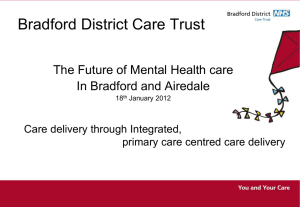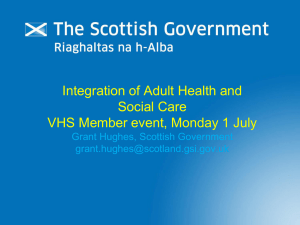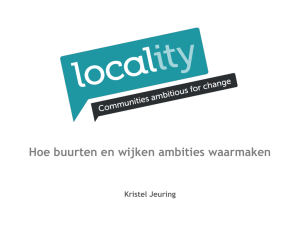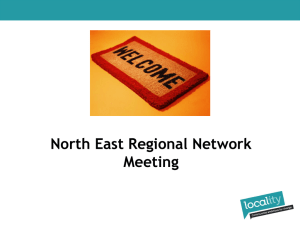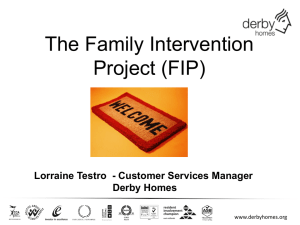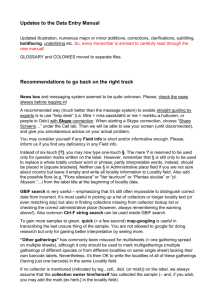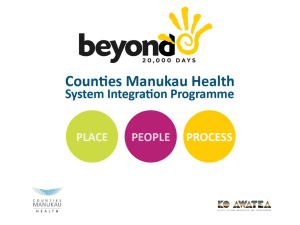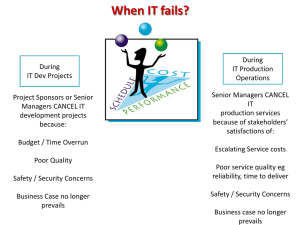What are the barriers and solutions to cross boundary working?
advertisement
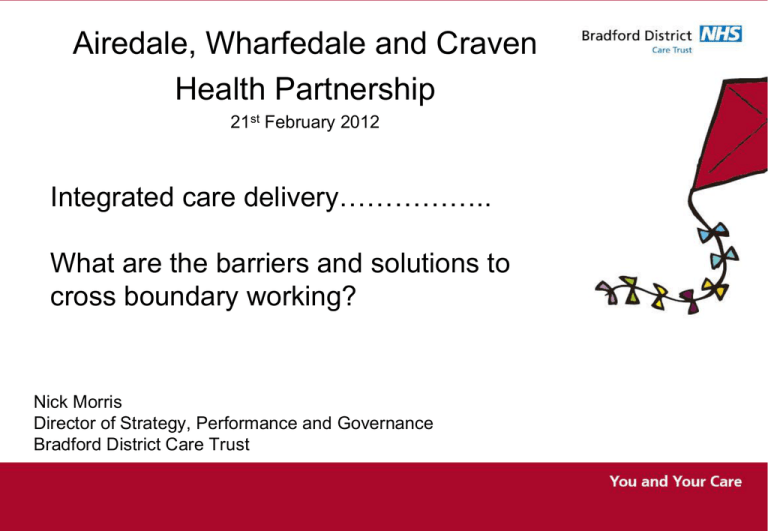
Airedale, Wharfedale and Craven Health Partnership 21st February 2012 Integrated care delivery…………….. What are the barriers and solutions to cross boundary working? Nick Morris Director of Strategy, Performance and Governance Bradford District Care Trust Barriers: • Pressure: – Economic – Demand v capacity • Leading to: – Defensive mentality – Short term-ism • Interpretation of rules and requirements – Divergent visions and aspirations – Different populations • Enabling issues: – Shared information, IT, etc.. • Lack of any unifying objectives – Organisational imperatives • Finance as a driver • Lack of good will….. Solutions: • Times of growth and optimism • Common and agreed understanding of the problem • A jointly held vision – that is customer focused – Integrated teams that have a common focus • Good will – people with the right attitudes – willingness to do it together • Leading to: – Shared risk taking – ‘Pooled budgets’ – Mutual benefits rather than personal/organisational benefits The Health Economy The whole health economy needs to establish new models of care delivery. • Drivers: – A shift from hospital care requires community services to be more effective and proactive – greater capacity and productivity – delivered through partnership – Growing demand/populations require earlier - preventative interventions – Growing demand requires increased capacity at the primary and community interface to prevent un-due escalation in responses – A lean approach to care coordination (across partners) – reduce: bureaucracy, ineffective handovers, risk, improve: patient experience and effectiveness • We need a new approach for the delivery of care to the economy A Vision for Community Services Acute Hospital Care Pro-active case mgt Social Care Pro-active case mgt A Comprehensive - Integrated health and social care services that provides coordinated care to individuals and their Communities - horizontal integration Pro-active case mgt Pro-active case mgt Primary care based services (99%+ of people registered with GP’s) The local population – social care need Locality Management Locality Acute Hospitals Airedale, Wharfedale and Craven Patient flows predominantly from this locality into Airedale NHS FT Clinical Commissioning Groups (CCG’s) Airedale and Craven CCG Local Authority North Yorkshire (Craven DC) and BMDC (Keighley) BDCT – MH/LD and community services Specialist District-wide Services (Acute care pathway, Crisis services, in-patient and residential) A common understanding of the population to be served allows planners to develop joint initiatives Registered and Resident Population issues are Of less significance at this Level – hence joint plans Agreements will become workable A New Model of Care Delivery Community staff aligned to practice populations Neighbourhood Primary Care Practice A management and supervisory structure supports the coordinated work of a range of different practitioners working to deliver integrated care DN’s, HV’’s IAPT Primary Care Practice School nursing, Gateway worker, etc CMHT, OPMH staff Podiatry, etc Geographic ‘Zone’ Primary Care Practice The link to primary care allows for integrated planning with primary care management and supervisory systems Staff visible at this level – ‘autonomous’ in delivery to defined case loads mapped to GP practices Association to ‘neighbourhood’ concept allows for integration of health need with population ‘social’ need Potential integration of social care within joint integrated teams Fully aligned with Intermediate Care + Potential for benefits across other care pathways Note: some specialist staff/teams will be deployed across teams (locality and district) But accessible to support the delivery at practice group level A New Model of Care Delivery Practice Population 1,000 – 15,000 A Primary Care Practice Volume of need is sufficient to allow for staff to be allocated to the practice population – i.e. their case load is drawn from this population entirely: example – District Nursing, HV’s, Counselling Integrated delivery – practice staff work together to support the practice population Combined Practice Population Approx 15,000 – 30,000 A Group of Practices Scale: 1 large Practice – 4 or 5 small single Handed practices Staff resources too thin to delegate to individual practices – hence staff allocated to a group of primary care practices - population is sufficient to support a case load drawn from this population entirely: example – CMHT staff, ACCT, … Integrated delivery – practice staff work together to support the practice population A Locality aggregated from a larger number of practice Populations (Scale approx 100,000 pop) Some specialist staff/teams will be deployed across larger groupings of practices at locality scale They will support integrated work at practice level populations Note: There are some specialist staff who will retain a Trust wide remit Benefits The benefits have been identified as: – Improved focus of care at community – earlier interventions, closer to home – Improved patient experience • Horizontal integration, reduced handoffs/handovers, single assessment, shared care. Also enables mobile (agile) working practices – Enhanced relationship • Patient – customer focused care – simple access • practice staff/systems (care model) – integration with primary care practice • Neighbourhood level – integrated health and social care – population focus rather than diagnosis • Planning and provider systems - partner organisation – Integration benefits – Reduced risk – less handoff, shared information – Improved Quality – speed of referral/intervention, responsiveness and access to information/support – Efficiency gains • Financially – Locality Mgt Structure • Productivity at Community level – meeting demographic challenges head on
